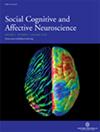比赛的速度
IF 3.1
2区 医学
Q2 NEUROSCIENCES
引用次数: 0
摘要
当被要求根据 "种族 "对人脸进行分类时,人们通常会比对自己种族的人脸更快地对其他种族的人脸进行分类。这种 "其他种族分类优势 "被认为反映了人们对其他种族面孔特有的早期视觉信号的敏感性的增强,并可在面孔呈现的 200 毫秒内表现出来。然而,最近的研究强调了信号强度在这一效应中的重要性,人脸图像的视觉降级显著增强了这一效应,并在极低的视觉质量水平上暴露出行为阈值,在这一阈值上,其他种族的视觉信号能够被感知,而同一种族的信号则不能被感知。本研究通过脑电图和准确性/反应时间研究了信号强度对大脑种族分类过程的影响。在复制之前观察到的其他种族分类优势增强的同时,我们还发现在早期 P1 峰以及后期 N170 和 N250 峰中对其他种族面孔的敏感性增强。然而,这些效应与人脸刺激中不同程度的信号强度有关,这表明种族分类可能涉及不同类型的知觉和神经过程,而不是一个独立的过程。种族感知的速度取决于人脸信号的强度。本文章由计算机程序翻译,如有差异,请以英文原文为准。
The Speed of Race
When asked to categorize faces according to ‘race’, people typically categorize other-race faces faster than faces belonging to their own race. This Other Race Categorization Advantage is thought to reflect enhanced sensitivity to early visual signals characteristic of other-race faces, and can manifest within 200 ms of face presentation. However, recent research has highlighted the importance of signal intensity in this effect, where visual-degradation of the face images significantly enhances the effect and exposes a behavioural threshold at very low levels of visual quality where other-race visual signals are able to be perceived while same-race signals are not. The current study investigated the effect of signal intensity in race categorization processes in the brain through electroencephalography and in accuracy/reaction times. While replicating the previously observed enhancement of the other-race categorization advantage, we also found enhanced sensitivity to other-race faces in early P1 peaks, as well as later N170, and N250 peaks. These effects, however, related to the varying levels of signal intensity in the face stimuli, suggesting that race categorization may involve different types of perceptual and neural processes rather than one discrete process. The speed at which race is perceived depends on the intensity of the face signal.
求助全文
通过发布文献求助,成功后即可免费获取论文全文。
去求助
来源期刊
CiteScore
6.80
自引率
4.80%
发文量
62
审稿时长
4-8 weeks
期刊介绍:
SCAN will consider research that uses neuroimaging (fMRI, MRI, PET, EEG, MEG), neuropsychological patient studies, animal lesion studies, single-cell recording, pharmacological perturbation, and transcranial magnetic stimulation. SCAN will also consider submissions that examine the mediational role of neural processes in linking social phenomena to physiological, neuroendocrine, immunological, developmental, and genetic processes. Additionally, SCAN will publish papers that address issues of mental and physical health as they relate to social and affective processes (e.g., autism, anxiety disorders, depression, stress, effects of child rearing) as long as cognitive neuroscience methods are used.

 求助内容:
求助内容: 应助结果提醒方式:
应助结果提醒方式:


